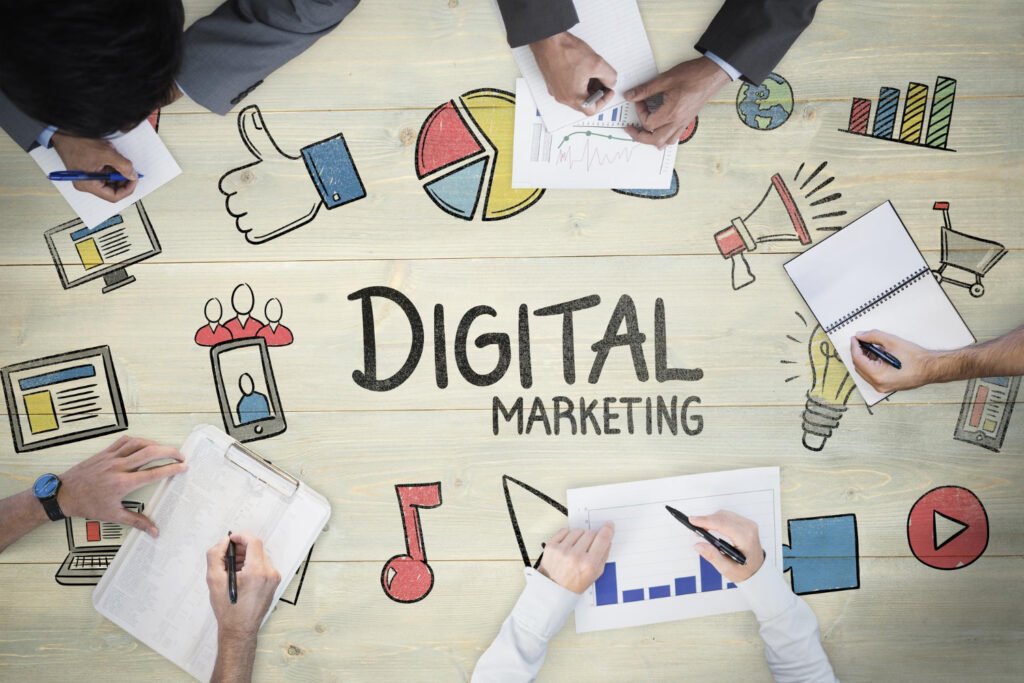In today’s highly competitive business landscape, having a robust digital marketing strategy is essential for growth and sustainability. A well-thought-out digital marketing strategy allows businesses to reach a larger audience, engage with their target customers, and build brand loyalty. However, to succeed in the digital age, companies must understand and implement the key components that form the foundation of a successful digital marketing strategy.
In this article, we will explore the vital elements of a digital marketing strategy and how businesses can leverage them to thrive in the online space.
1. Clear Business Goals and Objectives
The first step in creating a successful digital marketing strategy is identifying clear and measurable business goals. Without a roadmap or a set of well-defined objectives, a marketing strategy risks being disjointed and unfocused. Your goals will serve as the foundation for every decision made within the digital marketing plan.
Setting SMART Goals
To make your goals more actionable and measurable, it’s essential to follow the SMART framework:
- Specific: Clearly define what you want to achieve.
- Measurable: Identify how success will be measured.
- Achievable: Set realistic and attainable goals.
- Relevant: Ensure goals align with broader business objectives.
- Time-bound: Establish a deadline for achieving the goals.
Examples of business goals in digital marketing might include increasing website traffic, improving conversion rates, growing social media engagement, or boosting sales from online channels.
2. Target Audience Identification
Understanding your target audience is the cornerstone of any digital marketing strategy. Without a clear picture of who your customers are, it’s nearly impossible to craft content, messages, and campaigns that resonate with them.
Developing Buyer Personas
A buyer persona is a semi-fictional representation of your ideal customer based on research and data. It includes demographic information, interests, challenges, preferences, and behaviors. Creating detailed buyer personas helps businesses tailor their digital marketing efforts to address the unique needs and pain points of their target audience.
Segmentation
Once buyer personas are established, segmentation allows businesses to further refine their targeting. By segmenting your audience into smaller, more specific groups based on criteria like location, age, gender, or purchase behavior, you can create personalized marketing campaigns that appeal directly to each segment.
3. Comprehensive Content Strategy
Content is king in digital marketing, and a well-executed content strategy is critical to attracting, engaging, and converting your audience. A content strategy outlines what types of content you will produce, how often, and through which channels.
Content Types
Different content formats appeal to different audience segments and stages of the buyer’s journey. Common content types include:
- Blog posts for educational and informational purposes.
- Videos to engage with audiences visually and emotionally.
- Infographics for digestible data and statistics.
- Ebooks and Whitepapers for in-depth exploration of topics.
- Social media posts for brand visibility and engagement.
- Email newsletters for nurturing leads and staying top-of-mind.
SEO Optimization
Content strategy should always include Search Engine Optimization (SEO). Optimizing your content with targeted keywords ensures that your content ranks well on search engine results pages (SERPs), which can significantly increase your organic visibility. Moreover, crafting valuable, shareable content can generate backlinks, boosting your authority in search rankings.
4. Social Media Marketing
Social media has become a central platform for brands to connect with customers. A successful digital marketing strategy requires a comprehensive social media marketing approach to foster relationships, enhance brand awareness, and drive traffic.
Choosing the Right Platforms
The first step in social media marketing is choosing the right platforms. Not all social media channels are suitable for every business, so it’s essential to know where your target audience spends most of their time. Whether it’s Facebook, Instagram, LinkedIn, Twitter, or TikTok, each platform serves a unique purpose.
Consistency and Engagement
Consistency is key in social media. Posting regularly, interacting with followers, and engaging in conversations with your audience helps build trust and establish a loyal following. Responding to comments, messages, and reviews shows your audience that you value their feedback.
5. Paid Advertising (PPC)
Paid advertising is a crucial component of a successful digital marketing strategy. Pay-per-click (PPC) ads enable businesses to target specific keywords and reach their audience through paid search results, social media ads, and display ads.
Search Engine Ads
Google Ads is one of the most popular paid advertising platforms. With a well-structured Google Ads campaign, businesses can target relevant keywords and appear on the first page of search results, increasing visibility and driving qualified traffic.
Social Media Advertising
Social platforms like Facebook, Instagram, and LinkedIn offer advanced targeting options that allow businesses to reach their audience based on interests, demographics, behaviors, and location. Social media ads can effectively complement organic efforts and drive conversions.
Retargeting
Retargeting allows businesses to target users who have previously interacted with their website or app but did not complete a desired action, such as making a purchase. Through retargeting campaigns, businesses can encourage these visitors to return and finalize their conversions.
6. Email Marketing
Email marketing remains one of the most effective ways to nurture leads and build lasting customer relationships. It’s a powerful tool for delivering personalized messages, promotions, and valuable content directly to your audience’s inbox.
Building an Email List
Building a quality email list is fundamental to email marketing. This involves collecting email addresses through sign-up forms, lead magnets, or opt-in incentives like discounts or free resources.
Personalization
Personalizing email content to cater to individual customer preferences and behaviors significantly increases the effectiveness of email campaigns. Addressing recipients by name, recommending relevant products, and sending personalized offers enhances customer experience and engagement.
Automated Campaigns
Email automation tools allow businesses to send pre-scheduled emails based on user actions, such as abandoned cart reminders, welcome series, and post-purchase follow-ups. Automation saves time and ensures timely, relevant communication with customers.
7. Data Analytics and Performance Tracking
The success of a digital marketing strategy hinges on continuous monitoring, measurement, and optimization. Collecting and analyzing data helps businesses understand what’s working and what’s not, enabling them to make data-driven decisions and improve their campaigns.
Key Performance Indicators (KPIs)
To track the effectiveness of your digital marketing efforts, you need to establish key performance indicators (KPIs) that align with your goals. Common KPIs include website traffic, conversion rates, click-through rates (CTR), engagement metrics, and return on investment (ROI).
A/B Testing
A/B testing involves comparing two versions of a marketing asset (such as an email, landing page, or ad) to determine which one performs better. This data-driven approach helps optimize campaigns and improve results over time.
8. Continuous Improvement and Adaptation
A successful digital marketing strategy isn’t static—it requires constant adaptation and optimization. The digital landscape is dynamic, with new trends, tools, and technologies emerging regularly. Therefore, businesses must remain agile, learning from past campaigns and continuously refining their strategies.
Regularly reviewing performance metrics, experimenting with new tactics, and staying updated on industry developments ensures that your strategy remains effective and relevant.
Conclusion
A successful digital marketing strategy is multifaceted, involving several key components that work together to achieve business goals. By defining clear objectives, understanding your audience, creating valuable content, and leveraging the right tools and channels, businesses can effectively reach their target market and achieve long-term success. Continuous analysis, adaptation, and optimization ensure that your digital marketing strategy remains competitive and impactful in the ever-evolving digital world.


